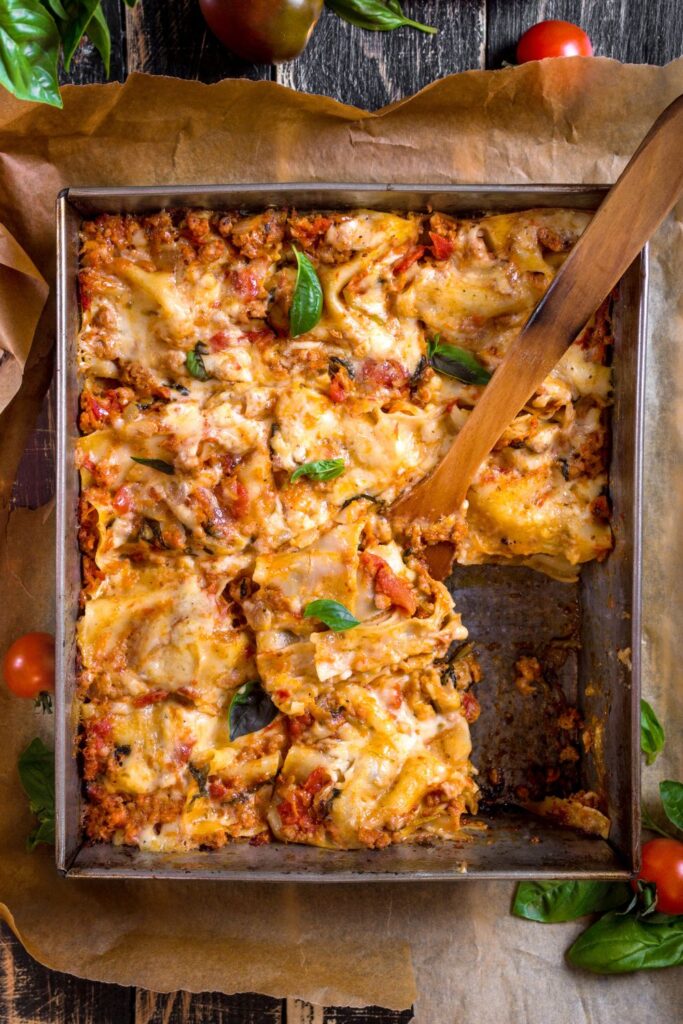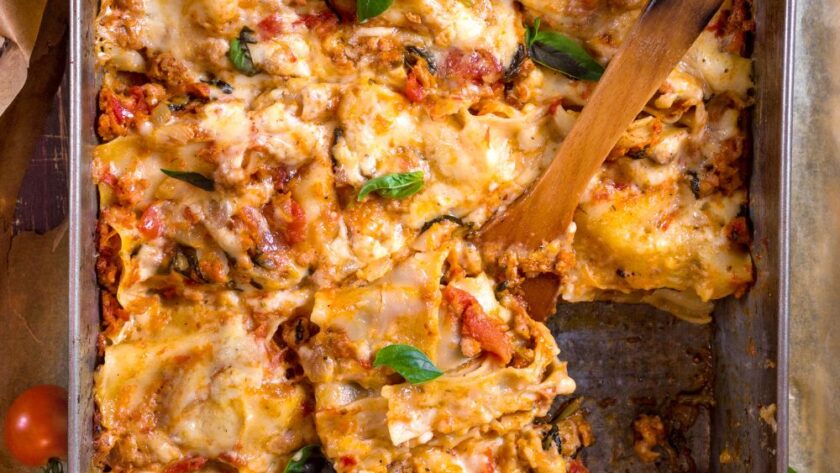There’s just something about lasagne that makes you feel like you’ve cooked something proper. The smell of that slow-simmered ragu, bubbling béchamel, and golden cheese crust? It’s comfort on a plate. This one’s not your quick fix, but oh, it’s worth it. The kind of thing you make when you’ve got a bit of time and maybe a good bottle of red open.
Making everything from scratch — even the pasta — might sound like a faff, but it quickly becomes a rhythm. Dough, sauce, stir, layer, bake. And when it all comes together in one bubbling dish? Magic. One bite and you’re in some tiny Italian kitchen, even if your real kitchen’s got tea towels on the radiator and a cat watching suspiciously from the windowsill.
Why You’ll Love It
- Deep, savoury ragu made with both beef and pork mince
- Creamy, cheesy béchamel that pulls everything together
- Layers of fresh pasta (homemade or not) for that proper bite
- A dish made to impress — great for dinners with mates or family
- Leftovers reheat like a dream
- You’ll feel like a kitchen wizard by the end
Ingredients
Ragu Sauce
- 500g beef mince
- 500g pork mince
- 4 tbsp olive oil
- 2 white onions, finely diced
- 2 carrots, finely diced
- 2 celery stalks, finely diced
- 6 garlic cloves, crushed
- 2 tbsp tomato paste
- ½ cup white wine
- 700g passata
- 5 ripe tomatoes, peeled and diced
- ½ cup water
- Salt & pepper
Béchamel Sauce
- 100g unsalted butter
- 1 tbsp olive oil
- 2 garlic cloves, crushed
- ½ cup plain flour
- 3 cups milk
- 50g gruyère, grated
- 50g parmesan, grated
- Salt & pepper
Pasta
- 400g 00 flour
- 50g semolina flour
- 250g eggs
- 1 tsp flaky sea salt
Assembly
- 1 box fresh lasagne sheets (or your own)
- 20g parmesan
- 20g mozzarella
How to Make It
Get the dry bits sorted
Mix your 00 flour, semolina, and salt in a big bowl. Tip it all onto a clean surface and make a well in the middle like you’re starting a bread volcano.
Sort the wet
Crack the eggs into that well and gently whisk them, dragging in flour from the sides until you’ve got a sticky paste. Then go hands-on — knead for 10 minutes until smooth and firm. Wrap and let it rest for 30 mins.
Make the dough
Once rested, cut off a chunk and roll it out — either with a pasta machine or a rolling pin. You want it about 3mm thick or less. Dust with flour so it doesn’t stick and set the sheets aside.
Shape your pasta
Cut the pasta sheets to fit your dish. Boil them for 1–2 minutes in salted water, then dunk in ice water and lay out to dry on a tea towel.
Wrap and steam
(Skip this — we’re not wrapping anything today.)
Cool and unwrap
(Not needed — just don’t burn your fingers on the pasta water!)
Finish it off
For the ragu: Brown the mince in batches — don’t crowd the pan. Remove, then sauté onion, carrot, celery until soft. Add garlic and tomato paste, then the wine — let it bubble. Add tomatoes, passata, water, and the browned mince. Simmer, uncovered, for 2 hours.
For the béchamel: Melt butter, stir in garlic and oil. Whisk in flour, then slowly add milk a bit at a time. Keep whisking until thick, then stir in cheese.
Layer it all: Start with ragu, then pasta, then béchamel. Repeat for about four layers. Top with extra cheese. Bake at 180°C for 40 minutes. Rest for at least 30 minutes before cutting — seriously.

Common Mistakes and How to Dodge Them
- Overcrowding the mince? It won’t brown. Cook in batches.
- Watery béchamel? Added the milk too fast. Go slow and whisk constantly.
- Too greasy? Don’t go wild with cheese on top — a little goes a long way.
- Rushing the ragu? Give it time. Those two hours make all the difference.
- Cut too soon? It’ll fall apart. Let it rest so it firms up and slices cleanly.
Storage and Reheating
Fridge:
Cool, then store covered for up to 3 days.
Freezer:
Slice and wrap portions. Keeps for 2–3 months.
Microwave:
Reheat on medium for 3–4 mins, cover with a damp paper towel.
Oven:
Cover with foil and bake at 180°C for 20 mins.
Frequently Asked Questions
Can I use store-bought pasta?
Absolutely — fresh sheets are best if you’re skipping the handmade version.
Why simmer the sauce uncovered?
So it reduces and intensifies. It should be rich, not watery.
Can I make this ahead?
Yep! Assemble and refrigerate, then bake when needed.
Is it worth making fresh pasta?
Honestly? Yes. The bite and flavour are next-level. But store-bought won’t ruin your lasagne.
How do I stop the béchamel from going lumpy?
Whisk constantly and add the milk gradually. And breathe.
Nutrition Facts (Per Serving)
Calories: 510
Fat: 25g
Carbs: 34g
Protein: 28g
Sodium: 670mg
Sugar: 9g
More Delia Smith Recipe:

Delia Smith Lasagne Ragu Recipe
Description
A rich, slow-cooked lasagne layered with beef and pork ragu, creamy béchamel, and fresh pasta for a proper showstopper.
Ingredients
Ragu Sauce
Béchamel Sauce
Pasta
Assembly
Instructions
- Make and roll the pasta dough; rest and cut into sheets.
- Brown mince in batches; cook down onion, carrot, celery, garlic.
- Stir in tomato paste, wine, tomatoes, passata, water, and simmer 2 hrs.
- Make béchamel: butter, flour, milk, cheese, stir until thick.
- Boil and chill pasta sheets.
- Layer ragu, pasta, béchamel, repeat. Top with cheese.
- Bake at 180°C for 40 mins. Rest before slicing.
Notes
- Brown the mince properly to build flavour.
- Add milk gradually when making béchamel.
- Let the finished lasagne rest to keep slices neat.
- You can freeze portions easily — just wrap well.

